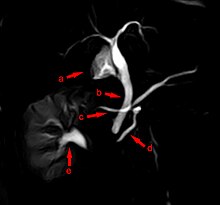Pancreas divisum
| Classification according to ICD-10 | |
|---|---|
| Q45.3 | Other congenital malformations of the pancreas and pancreatic duct |
| ICD-10 online (WHO version 2019) | |

MRCP in pancreas divisum: (a) gallbladder, (b) bile duct that crosses the (c) long accessory pancreatic duct, (d) short pancreatic duct together with the bile duct to the major duodenal papilla, (e) with the renal hollow system shown.
A pancreas divisum (Latin divisus: separate) is created by an incomplete fusion of the dorsal duct ( ductus pancreaticus accessoryius ) with the ventral duct ( ductus pancreaticus ) of the pancreas during the fetal development . Thus the two ducts open into the duodenum via separate papillae ( papilla duodeni major and minor ) .
The relative narrowness of the papilla duodeni minor is believed to be the cause of the acute pancreatitis more common in the pancreas divisum .
The pancreas divisum is the most common congenital malformation of the pancreas. A pancreas divisum is found in up to 7.5% of the patients examined using endoscopic retrograde cholangiopancreatography (ERCP).
Individual evidence
- ^ Gunther Rexroth: Gastroenterology. 1st edition. Huber Verlag, 2005, ISBN 3-456-84057-8 , p. 355.
- ^ Vay Liang W. Go: The Pancreas - Biology, Pathobiology and Disease. 2nd Edition. Ravers Press, 1993, ISBN 0-88167-986-0 , p. 1032.
Web links
Wikibooks: Surgery: Pancreas divisum - learning and teaching materials